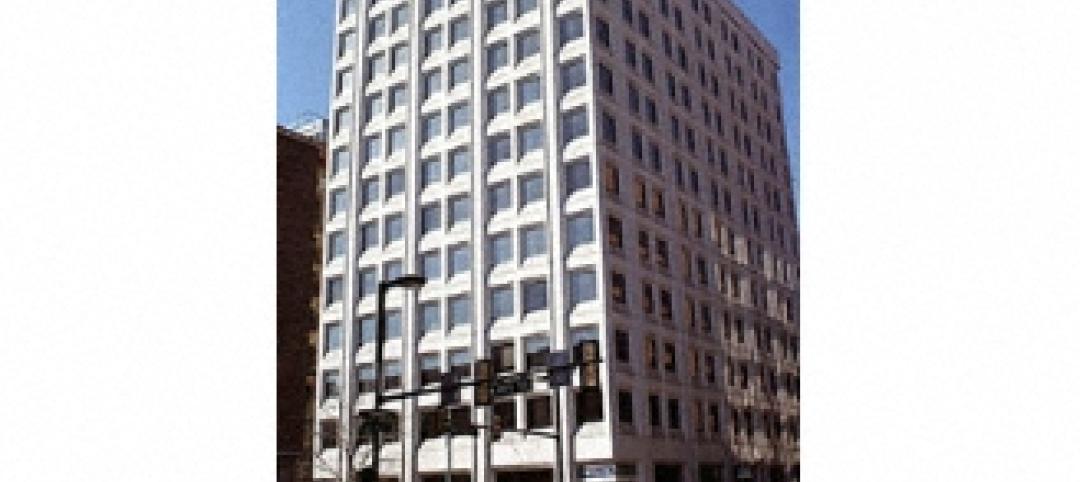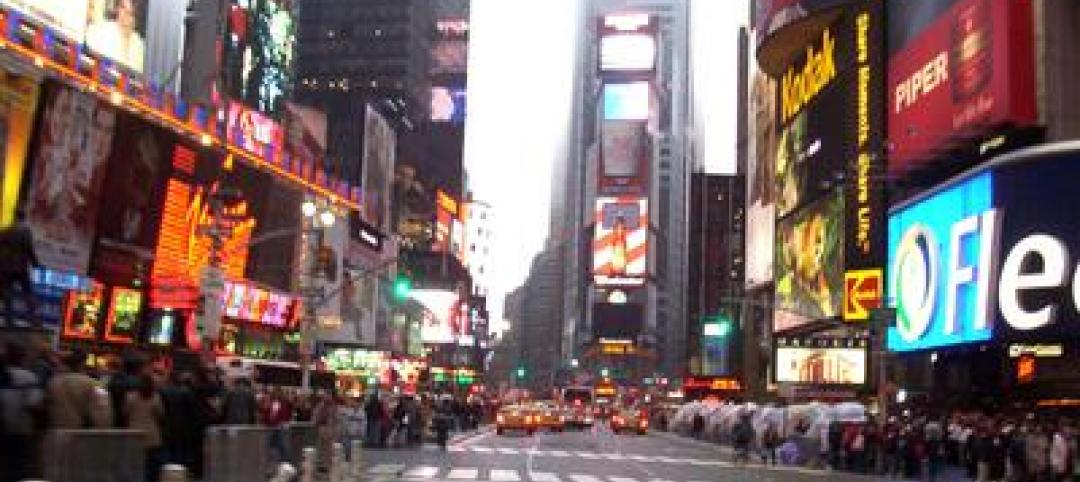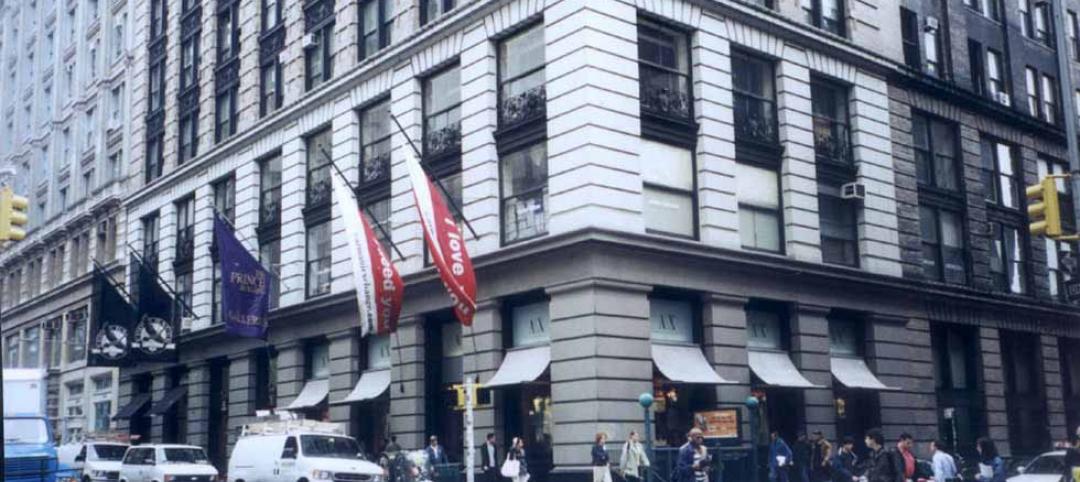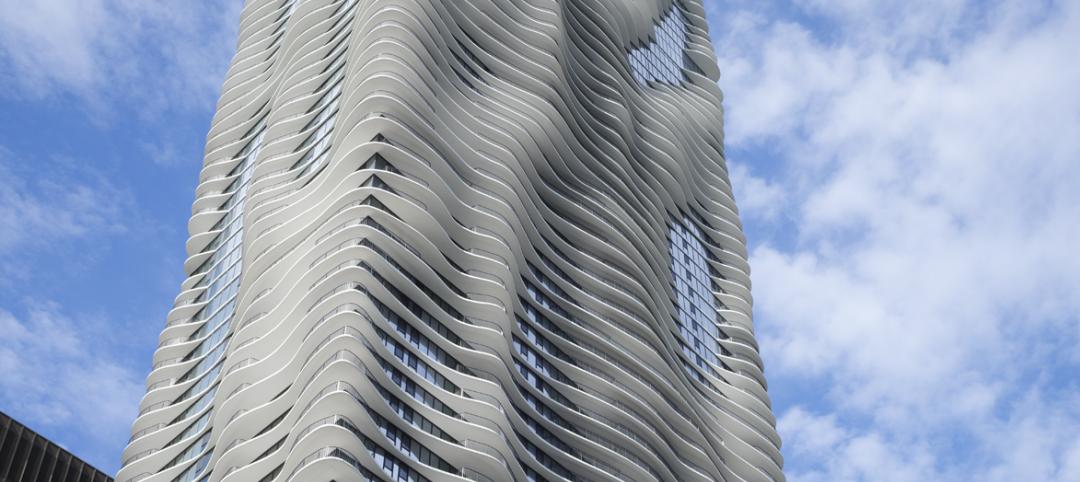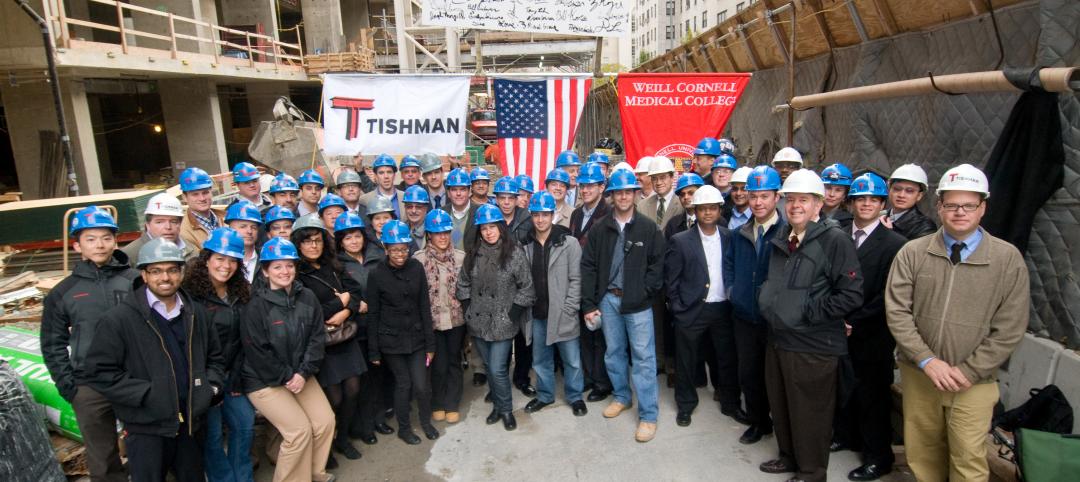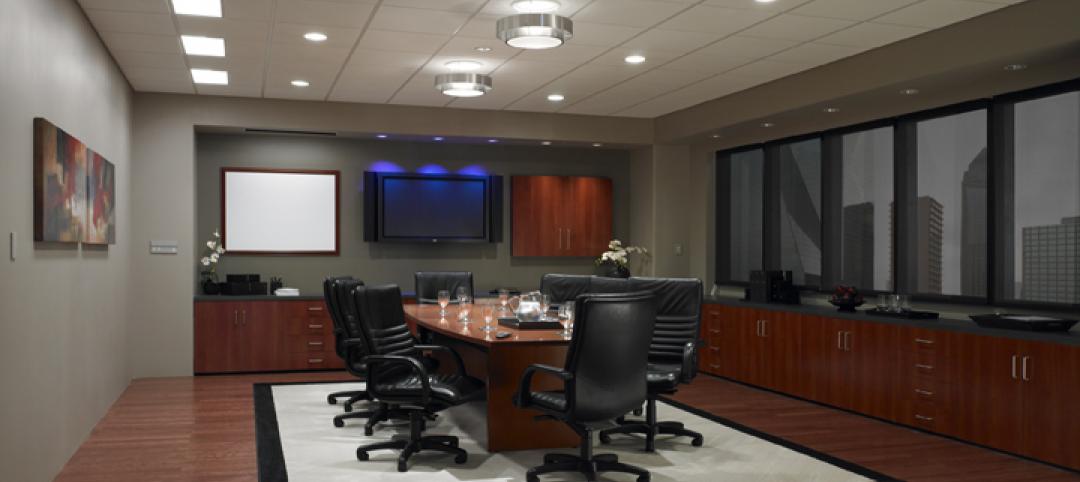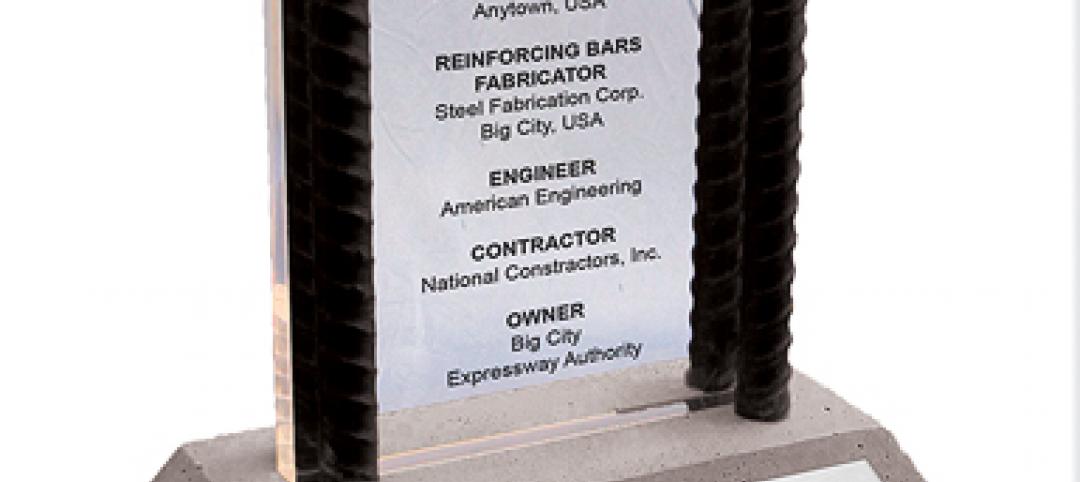Saint Gobain, the giant building materials supplier, has released the results of a three-year-long study that compared occupant comfort for the 800 employees at its old headquarters in Valley Forge, Pa., with the comfort levels for those same employees after they moved into the company’s new 277,000-sf North American headquarters in Malvern, Pa., which opened in October 2015.
That new LEED Platinum-certified building—an adaptive reuse of an office building that entailed 85% renovation and 15% new construction—is a “living laboratory” for Saint Gobain’s current and newly created products. The headquarters also showcases more than 60 innovative technologies.
The four-phase study, buttressed by a 76-question employee survey, found significant improvements in employees’ perceptions about indoor air quality, visual comfort, and acoustic comfort as a result of Saint Gobain’s “multi-comfort design approach” that combines sustainability, aesthetics, and comfort to improve occupant well-being. However, improving thermal comfort proved to be a harder nut to crack.
The study’s results are informing Saint Gobain’s new 30-story worldwide headquarters under construction in Paris.
Saint Gobain “wants to be the leader in habitat” by aggressively promoting its multi-comfort approach, says Stanley Gatland II, Manager of Building Sciences and Comfort for the company’s CertainTeed division. “We want to make occupant outcomes part of the conversation” with customers, adds Lucas Hamilton, CertainTeed’s Manager of Building Science Applications.
Four-step process
To evaluate the impact and efficacy of multi-comfort design elements in the new headquarters, Saint-Gobain partnered with a group of experts led by Dr. Ihab Elzeyadi, Director of the University of Oregon’s High Performance Environments (HiPE) Lab, to conduct an extensive four-phase comparative analysis of Indoor Environmental Quality (IEQ).
In the first phase of the study, a research team inspected the existing unoccupied Malvern facility prior to its adaptive renovation and reuse. In the second phase, the team examined the former Saint-Gobain headquarters in Valley Forge, to establish a benchmark for the performance of the new headquarters. In phase three, the team analyzed the new headquarters following envelope upgrades and interior design retrofits, but prior to occupancy. Finally, the fourth phase of the study assessed the newly completed Malvern headquarters post-occupancy.
Employees were questioned while they still worked at Valley Forge, as well in the fall of 2016 and 2017, after they had settled into the new headquarters. The questionnaires touched on 30 issues pertaining to workspace characteristics, indoor environment quality, comfort of ambient quality, health and well being, and productivity.
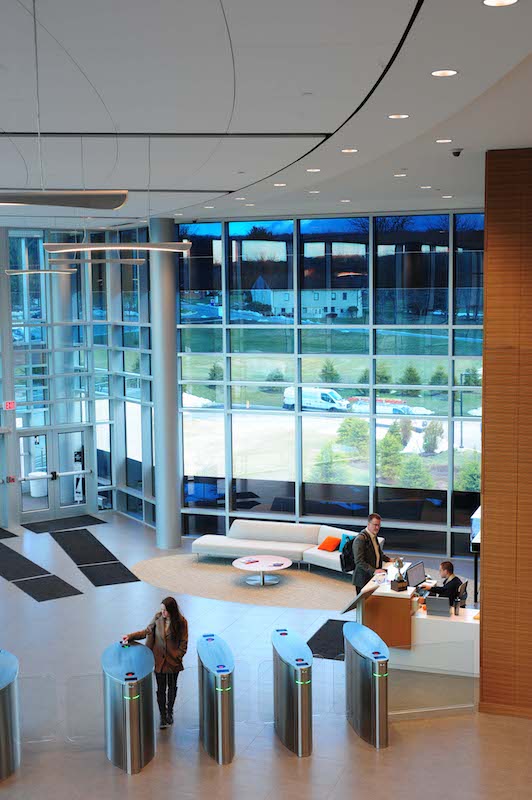
Electrochromic SageGlass on the building's southern and western facades contributed to employees' improved visual comfort. Image: Saint Gobain
The visual comfort parameter focused on daylighting and, more specifically, the relative impact of installing Saint Gobain’s SageGlass on the building’s western and southern façades. That electrochromic glazing provides three levels of tinting that are selected automatically in response to system programming and the changing light conditions throughout the day. These are detected by sensors on the roof of the building. The brightness of interior LED luminaires is similarly controlled according to incoming daylight.
In the old headquarters, less than half of the employees had access to daylight; in the new building, 92%. Only 4% of individuals now lack access to outside windows at their workspaces, compared to 23% at the former headquarters.
Unsurprisingly, employees reported a 56.4% overall improvement in visual comfort in the new headquarters, including gains of 30% to 60% in each of the following categories: overall lighting comfort, amount of light for working, glare from electric lights, ability to adjust to electric light, amount of daylight, glare from windows and the ability to adjust window shades.
To evaluate thermal comfort, Saint Gobain invested in significant upgrades to the new building’s core and envelope during renovation, including improved insulation, solar-reflective roofing, high-efficiency glazing, argon-gas-filled insulated glass, aluminum curtain wall systems and high-performance heating and cooling equipment.
The research team calculated thermal comfort conditions in accordance with ANSI/ASHRAE Standard 55-2013 and used electronic sensors over a long period of time to collect data on temperature, relative humidity, air velocity, globe temperature and air movement across various micro-climates in the Malvern facility.
Employees reported only a 4.8% improvement in thermal comfort in the new headquarters compared to the old. At key points during summer months, residents found themselves shifting from overly air-conditioned environments to hot, humid ones over a span of just a few hours.
Hamilton points out that the developer of the new headquarters (which wasn’t Saint Gobain) insisted on repurposing as much of the Malvern office structure as possible, including its mechanicals. Consequently, the HVAC system wasn’t always rightsized for a new headquarters with 116 collaborative spaces. Hamilton believes that thermal comfort results would be “a lot better” in projects that are completely new construction or have more extensive renovations.
“One lesson we learned was to spend more time reviewing whether to retain or replace existing building systems, especially when an extensive renovation will fundamentally change how a building will perform,” Saint Gobain stated in its report on the study.
Better results for acoustics and air quality
The study found much greater success in improving acoustic and indoor air quality. For acoustic comfort, the new headquarters was designed with sound-absorbing surfaces, high-performance interior partitions and exterior facades, isolating vibrating components in the HVAC system, and equipped with white noise machines to mask sound and manage speech intelligibility.
Saint Gobain also mapped the building’s sound absorption, sound levels, and workstation distraction distances to evaluate the effectiveness of its acoustic comfort tactics. It achieved a 42.2% improvement in employee perceptions.
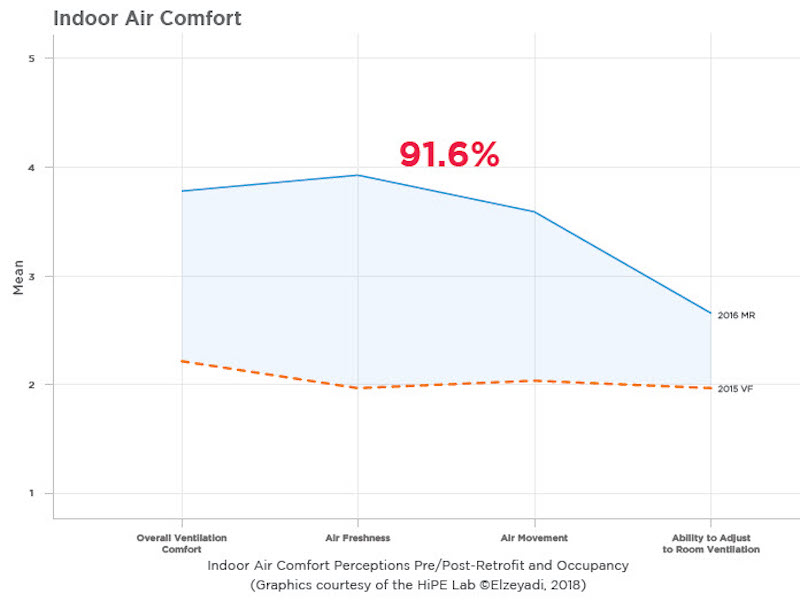
Employees' perceptions of the new headquarters' indoor air quality were significantly higher than how they felt about their old workplace. Image: Saint Gobain
The new building’s air quality was monitored along seven discrete facets of design: outdoor air ventilation, particulate filtration, dehumidification, moisture flow management, air leakage control, Volatile Organic Compound (VOC) control, and contaminant capture.
The design included two wall covering products: one with the ability to trap and neutralize 70% of harmful aldehydes, and another designed with an antimicrobial coating that actively repels and kills fungus and black mold. Drywall tape had mold- and mildew-resistant properties. Backerboard was moisture and mold resistant. Wallboard and ceilings absorbed and converted formaldehyde a safe, inert compound.
The result: a 91.6% improvement in employee perceptions about indoor air quality. “A week after moving into the [Malvern] building, some employees thought we were pumping oxygen into the building,” recalls Hamilton.
Overall, employees reported that levels of visual, acoustical and indoor air quality comfort were 26.3% greater on average at the Malvern facility than at Valley Forge. Additionally, occupants’ satisfaction with indoor environmental quality (a measurement composed of employees’ ratings of temperature, lighting quality, acoustics, air quality, smell, ergonomics and space function) improved by 47.9% in the new space.
Does employee comfort translate to better productivity? Maybe. Saint Gobain compared the performance of its internal sales team in its last week in Valley Forge with its first week in Malvern. The team fielded the same number of calls in both weeks, but qualified leads jumped by 150%, and sales in the latter week were $5.6 million higher.
Related Stories
| Dec 29, 2011
Seismic safety in question at thousands of California public schools
California regulators responsible for enforcing earthquake safety laws have failed to certify more than 16,000 construction projects in California public schools, increasing the risk that some projects may be unsafe, according to a state audit report.
| Dec 21, 2011
BBI key to Philly high-rise renovation
The 200,000 sf building was recently outfitted with a new HVAC system and a state-of-the-art window retrofitting system.
| Dec 20, 2011
Research identifies most expensive U.S. commercial real estate markets
New York City, Washington, D.C. and San Mateo, Calif., rank highest in rents.
| Dec 20, 2011
Aragon Construction leading build-out of foursquare office
The modern, minimalist build-out will have elements of the foursquare “badges” in different aspects of the space, using glass, steel, and vibrantly painted gypsum board.
| Dec 19, 2011
Chicago’s Aqua Tower wins international design award
Aqua was named both regional and international winner of the International Property Award as Best Residential High-Rise Development.
| Dec 19, 2011
Davis Construction breaks ground on new NIAID property
The new offices will total 490,998 square feet in a 10-story building with two wings of 25,000 square feet each.
| Dec 14, 2011
Belfer Research Building tops out in New York
Hundreds of construction trades people celebrate reaching the top of concrete structure for facility that will accelerate treatments and cures at world-renowned institution.
| Dec 13, 2011
Lutron’s Commercial Experience Center awarded LEED Gold
LEED certification of the Lutron facility was based on a number of green design and construction features that positively impact the project itself and the broader community. These features include: optimization of energy performance through the use of lighting power, lighting controls and HVAC, plus the use of daylight.
| Dec 12, 2011
AIA Chicago announces Skidmore, Owings & Merrill as 2011 Firm of the Year
SOM has been a leader in the research and development of specialized technologies, new processes and innovative ideas, many of which have had a palpable and lasting impact on the design profession and the physical environment.
| Dec 12, 2011
CRSI design awards deadline extended to December 31
The final deadline is extended until December 31st, with judging shortly thereafter at the World of Concrete.



